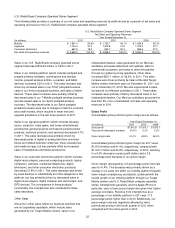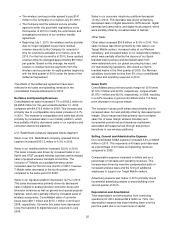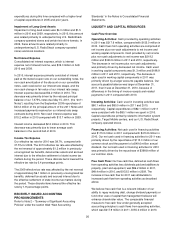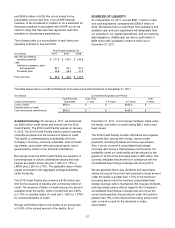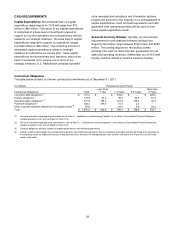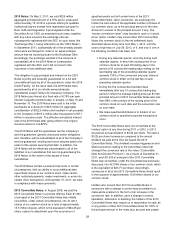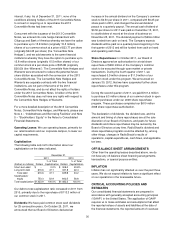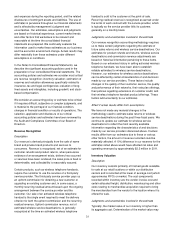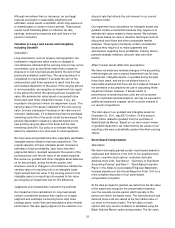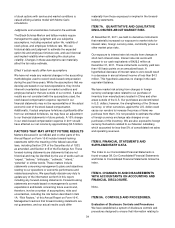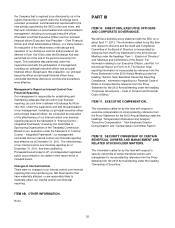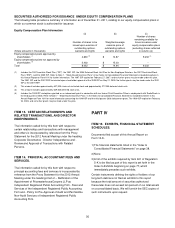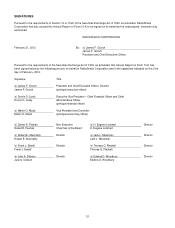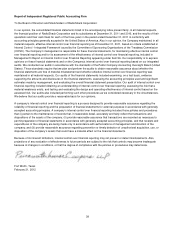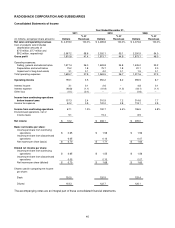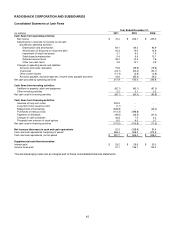Radio Shack 2011 Annual Report Download - page 40
Download and view the complete annual report
Please find page 40 of the 2011 Radio Shack annual report below. You can navigate through the pages in the report by either clicking on the pages listed below, or by using the keyword search tool below to find specific information within the annual report.32
be very complex and, therefore, requires a high degree of
judgment. In order for management to make the
appropriate determination of market value, the following
items are commonly considered: inventory turnover
statistics, current selling prices, seasonality factors,
consumer trends, competitive pricing, performance of
similar products or accessories, planned promotional
incentives, technological obsolescence, and estimated
costs to sell or dispose of merchandise such as sales
commissions.
If the estimated market value, calculated as the amount we
expect to realize, net of estimated selling costs, from the
ultimate sale or disposal of the inventory, is determined to
be less than the recorded cost, we record a provision to
reduce the carrying amount of the inventory item to its net
realizable value.
Effect if actual results differ from assumptions
We have not made any material changes in the
methodology used to establish our inventory valuation or
the related reserves during the past three fiscal years, and
we do not believe there is a reasonable likelihood that there
will be a material change in the future estimates or
assumptions we use to estimate our inventory valuation
reserves. Differences between management estimates and
actual performance and pricing of our merchandise could
result in inventory valuations that differ from the amount
recorded at the financial statement date and could also
cause fluctuations in the amount of recorded cost of
products sold. If our estimates regarding market value are
inaccurate or changes in consumer demand affect certain
products in an unforeseen manner, we may be exposed to
material losses or gains in excess of our established
valuation reserve. We believe that we have sufficient
current and historical knowledge to record reasonable
estimates for our inventory valuation reserves. However, it
is possible that actual results could differ from recorded
reserves.
Estimation of Reserves and Valuation Allowances for
Self-Insurance, Income Taxes, and Litigation
Contingencies
Description
The amount of liability we record for claims related to
insurance, tax and legal contingencies requires us to make
judgments about the amount of expenses that will ultimately
be incurred. We are insured for certain losses related to
workers' compensation, property and other liability claims,
with deductibles up to $1.0 million per occurrence. This
insurance coverage limits our exposure for any catastrophic
claims that result in liability in excess of the deductible. We
also have a self-insured health program administered by a
third-party covering the majority of our employees that
participate in our health insurance programs. We estimate
the amount of our reserves for all insurance programs
discussed above at the end of each reporting period. This
estimate is based on historical claims experience,
demographic factors, severity factors, and other factors we
deem relevant.
We are subject to periodic audits from multiple domestic
and foreign tax authorities related to income tax, sales and
use tax, personal property tax, and other forms of taxation.
These audits examine our tax positions, timing of income
and deductions, and allocation procedures across multiple
jurisdictions. Our accounting for tax estimates and
contingencies requires us to evaluate tax issues and
establish reserves in our consolidated financial statements
based on our estimate of current probable tax exposures.
Depending on the nature of the tax issue, we could be
subject to audit over several years; therefore, our estimated
reserve balances might exist for multiple years before an
issue is resolved by the taxing authority.
We are involved in legal proceedings and governmental
inquiries associated with employment and other matters.
Our accounting for legal contingencies requires us to
estimate the probable losses in these matters. This
estimate has been developed in consultation with in-house
and outside legal counsel and is based upon a combination
of litigation and settlement strategies.
Judgments and uncertainties involved in the estimate
Our liabilities for insurance, tax and legal contingencies
contain uncertainties because we are required to make
assumptions and to apply judgment to estimate the
exposures associated with these items. We use our history
and experience, as well as other specific circumstances
surrounding these claims, in evaluating the amount of
liability we should record. As additional information
becomes available, we assess the potential liability related
to our various claims and revise our estimates as
appropriate. These revisions could materially affect our
results of operations and financial position or liquidity.
Effect if actual results differ from assumptions
We have not made any material changes in the
methodology used to estimate our insurance, tax, or legal
contingencies reserves during the past three fiscal years,
and we do not believe there is a reasonable likelihood that
there will be a material change in the future estimates or
assumptions for these items. However, a 10% change in
our insurance reserves at December 31, 2011, would have
affected net income by approximately $4.0 million. As of
December 31, 2011, actual losses had not exceeded our
estimates. Additionally, for claims that exceed our
deductible amount, we record a gross liability and
corresponding receivable representing expected
recoveries, since we are not legally relieved of our
obligation to the claimant.


